Dr Theo-Ben Gurirab - Evolving into an Octogenarian
THE ICON WE HAVE COME TO KNOW OVER THE PAST EIGHT DECADES By David Wamambo - First published on 15 March 2018
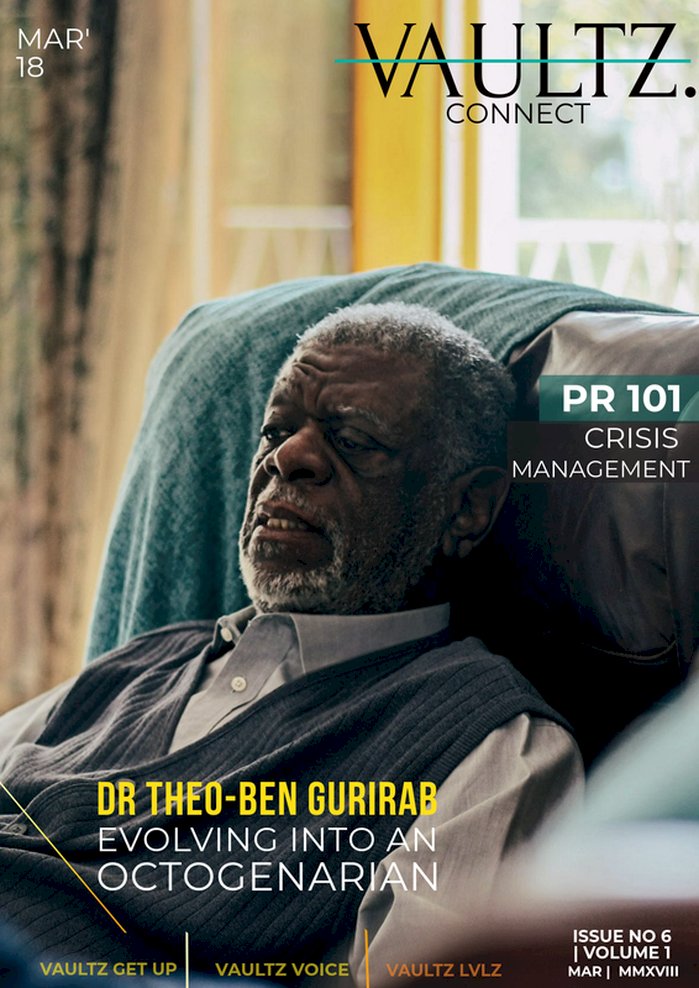
At 80 years, Dr Theo-Ben Gurirab still has the fire burning strong inside of him to still contribute to social justice, respect of the arts industry, fulfillment of the the gains of the liberation struggle not only for Namibians but for all people of colour. The story of Theo-Ben Gurirab has been known to most from a political stand point. He served Namibia as its second Prime Minister between 27 August 2002 and 19 March 2005. Prior to that, he was Minister of Foreign Affairs from 1990 to 2002, while he also served as the President of the United Nations General Assembly from 1999 to 2000. In 2015 he retired from active politics after serving as the Speaker of the National Assembly of Namibia from 2005 to 2015.
Gurirab is not only a well accomplished politician but a talented storyteller, when asked about his time in exile he said that the objective of SWAPO was to establish foreign missions, and did so in Dar es Salaam, and had offices in Senegal, Nigeria, London, India, New York and Washington D.C. The main reason for this in Gurirab's words was that they recognized that the world is not one country and foreign relations play a very key role in agenda setting. Gurirab tied this to how China is shaping the way in which the world perceives certain things as they are intentionally aligning them-selves with strategic partners in achieving their goals.
Looking at Gurirab's early days it would be absurd to think that a young boy born in the humble town of Usakos in the Erongo Region, would one day play a major role in leading his people out of captivity and eventually sit in a key position in global politics. This happened through a continuous yearning of growth not only for himself but the people around him. In 1960 he obtained a teaching Diploma from the Augustineum Training College in Okahandja, where he met the likes of the Honorables; Libertina Amathila, Ben Amathila, Hidipo Hamutenya and the sitting president Hage Geingob whom he later became close friends with. In 1962 he went into exile to USA during the Christmas holiday and eventually in 1964 he graduated with a degree in Political Science from the Temple University in Pennsylvania.
Describing how he went into exile he says, "A good friend of mine Dr Pohamba, who had attained basic education in Tsumeb suggested that they join the teachers that had gone into exile from the Ovamboland People’s Organization now SWAPO and we went through Tanzania, and at the time that was the ideal destination since the neighbouring countries in SADC were still colonized."
"Dr Nujoma had already left for Europe to go to school and other leaders went to settle in USA and Canada as well, and what separated our thinking from that of SWANU was that SWANU wanted education first and believed that would then solve the issues, however Nujoma emphasized that there was need to continue with the fight and then pave way to achieve the rest."
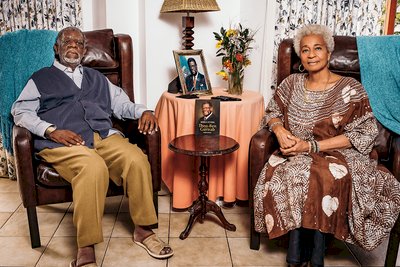
A tale of longevity in love...Dr Theo-Ben Gurirab and his wife Joan Guriras. Photograph by: Enzo Jantjies
EVOLVING IN EXILE AND
FINDING LOVE
It was during the time he was in exile that Dr Gurirab met his wife Joan Guriras, whom he met through the current President, Dr Hage Geingob. A very charming, warm and beautiful heart, with a warm smile she describes how they met with the same passion of a newly wedded bride, jokingly she tells the story of the first time they encountered each other at a function, and that her now husband's dress code had not really impressed her, "he was wearing red socks?, first of all, who wears red socks?" She cheerfully teases, and she then described what attracted her the most to her husband. "The content of his messages and his determination to see his people attain independence was something unique."
Art is one thing that surely the two of them have in common, Dr Gurirab humbly brags about his wife, "She virtually is a rare black woman whom at the time we met was doing things that were meant for white women, but as a black person she was a fashion buyer, and would travel to Italy, Hong Kong and return to USA and run a business as a black women."
At his recently held Octogenarian celebrations Dr Gurirab received gifts from many people that have come to know him, one of the strikingly distinguishable gifts was one from the second President of Namibia, Dr Hifikepunye Pohamba who presented him with a walking stick. At 80, Dr Gurirab appreciates the gift but still affirms it is not yet time to use it as he can still walk and is as fit as a fiddle .
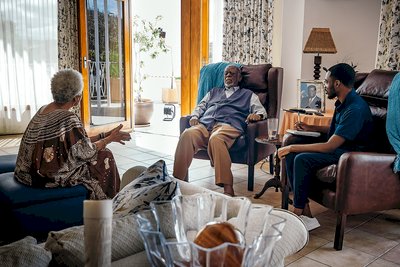
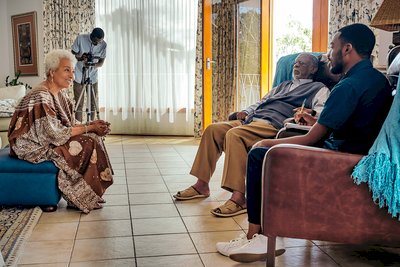
Our Editor David Wamambo chats with Dr Theo-Ben Gurirab and his wife Joan Guriras. Photograph by: Enzo Jantjies
EVOLVING THE ARTS
DEBATE GLOBALLY
We discussed the gifts, and this led our conversation into his perception of ART, "every generation has a duty, an obligation, challenge and opportunity for imagination, we have a seven year old grandson, he found from his grandmother a toy, he scribbles things on paper, he makes art... art is a necessary mechanism through which we think, dream and imagine changes that take place."
What many may not know is that Theo-Ben Gurirab has not only been a lover of art but a defender of art. In 1999 during his tenure as president of the United Nations General Assembly, he facilitated the return of stolen treasures from Africa during colonial times, stressing that there can be no reconciliation and healing in Africa until the continent’s sacred relics, icons, artworks and other priceless cultural objects were returned to their rightful owners.
Addressing delegates at General Assembly in 1999, he stressed, "Africans were not pleased that those stolen treasures adorned public museums, libraries, art galleries and private homes in foreign lands," on the eve of the new millennium to him it was important that work leaders lead the discourse in the world searching their souls and reflecting on their common humanity regarding the priceless African treasures that were to be returned to their rightful owners.
Due to his emphasis on the role played by art in identity and co existence, one would think that Dr. Gurirab had been prophesying cultural appropriation in the age of globalization. So to him it was important that measures were taken to respectfully honour art accordingly by accrediting and giving ownership to its originators. One can tell the zeal and passion behind his words was that of a freedom fighter who wanted more than just the repossessing of political power but the achievement of justices in all spheres of life.
"The importance of cultural artifacts was not simply one of aesthetics, but rather they formed an integral part of defining the identity and personality of the African family… Colonialism had also opened the way for an orchestrated campaign of theft. Hundreds of pottery pieces, gold and bronze coins, as well as many other artifacts had been stolen over the years," these were the words of Dr Gurirab addressing a 188-member UN General Assembly in 1999.
The contributions of Dr. Theo-Ben Gurirab at the UN regarding arts and culture ignited a paradigm shift in the way global leaders participated in the arts discourse and thus eased routes for artists to contribute to political discourse, projects such as the Global Citizen Festival part of a movement to end extreme poverty and whose goals closely relate to those that are closely aligned with the United Nations' Sustainable Development Goals (SDGs).
Hypothetically speaking the video of "I Was Here," of Beyoncé performing the song live at the United Nations General Assembly while images of volunteers doing humanitarian work were projected on the screen behind her, went through a door whose opening was paved for by our very own Dr. Theo-Ben Gurirab.
On the sidelines of his love for art Dr. Gurirab and his lovely wife Aunty Joan Guriras, shared with us his favorite artists, Hugh Masekela, Jazz Crusaders, Abdulah Ibrahim, Miriam Makeba, Loneliest Monk, to mention but a few.
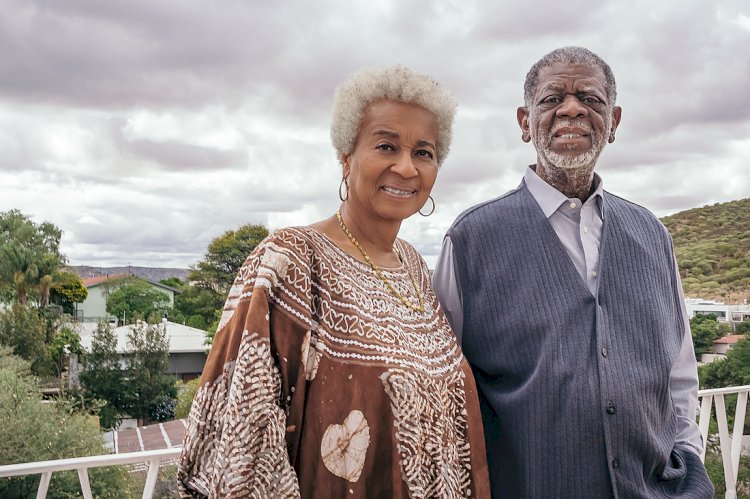
The Gurirabs... Photograph by: Enzo Jantjies
THE ICON WE HAVE COME TO LEARN FROM
OVER THE PAST EIGHT DECADES
One iconic element that stood out in the liberation movement of Namibia was the SWAPO TRIO comprising of the current President Dr. Hage Geingob, the late honorable Hidipo Hamutenya, and Dr. Gurirab. My next question was how they found each other in a world that had no MTC to make the connection? His response was they were privileged to find and build their friendships in social settings such as schools, sporting events and church. However what he said that caught my attention was that as young people we are in a privileged position to group ourselves with people that we build legacies with. This resonates with the legacy one can never take away from the young boy who grew up in a dry town called Usakos, whom as an octogenarian can say he has achieved as many accolades as are decorated to his name, a huge player in the liberation and development of Namibia. In his very own words, "We were able to dream together and learnt from those that had similar circumstances.
ACCOLADES TO DR. THEO-BEN GURIRAB'S NAME
- 1999: Doctorate of Law honoris causa, University of Namibia
- Order of the Sun First Class
- since 2002: member of the International Raoul Wallenberg Foundation
- 2000: Honorary Professorship of Foreign Affairs, China Foreign Affairs University, Beijing. Gurirab was only the third foreigner to be bestowed with this title.
- 2000: Founding member of the Olympic Truce Foundation in Athens
- 2011: Honorary President of the IPU























